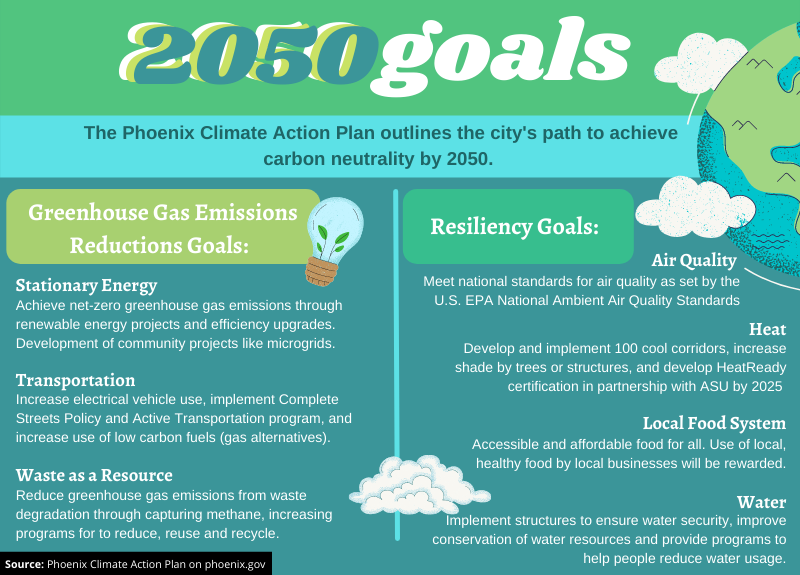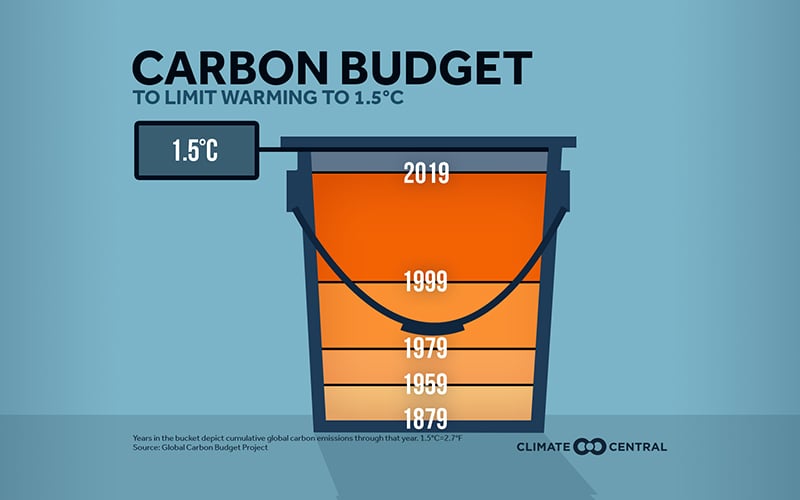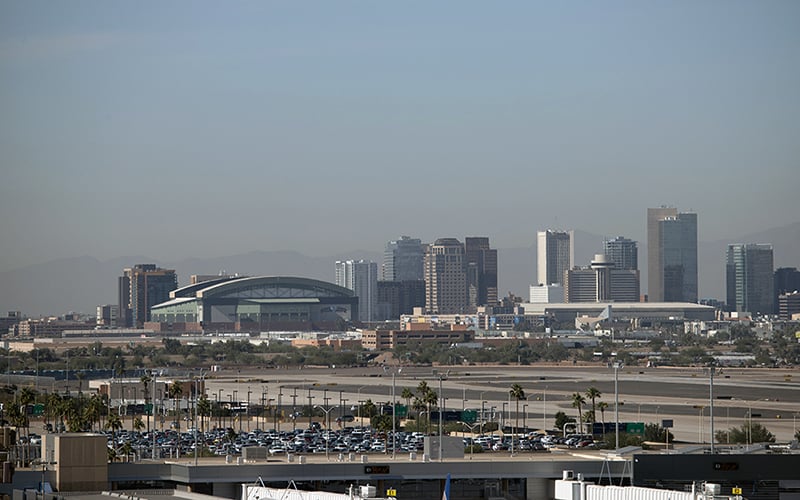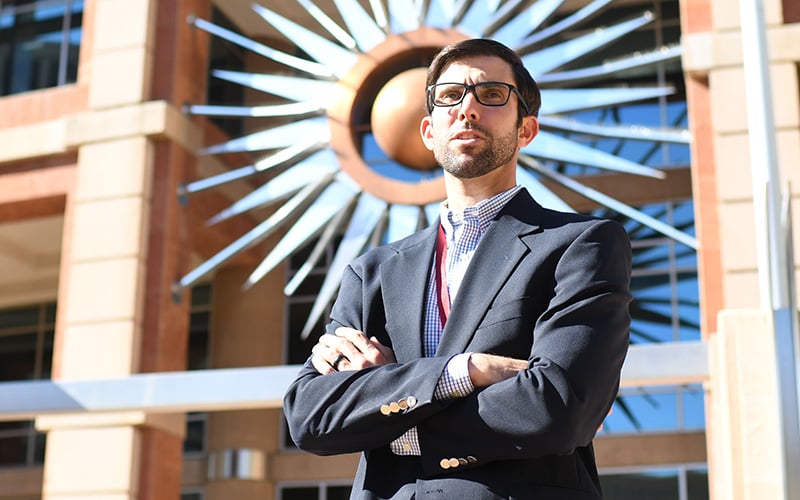PHOENIX – Locals are familiar with extended days of extreme heat in the summer – but they might not realize the average temperature in Phoenix has increased 4.3 degrees Fahrenheit since the 1970s, according to Climate Central.
The rising heat, along with the ongoing megadrought and persistently poor air quality, are driving issues behind how the country’s fifth-largest city plans to address climate change.
The City Council approved the updated Climate Action Plan on Oct. 12, 2021, just a few weeks before COP26 – the United Nations sponsored conference that brings countries together to discuss climate change – took place in Scotland.
COP26 set goals for leaders to develop and bring back home, most notably how to reach net zero carbon emissions by 2030 and limiting the increase in global temperatures to within 2.7 degrees Fahrenheit. The city’s updated plan is in line with those goals.
“By focusing on COP26, it provides a little bit of pressure for cities to step up because if cities don’t make some of these changes, there’s no way the federal government can actually achieve the commitments it’s promised. So it goes both ways,” said Sonja Klinsky, a professor at Arizona State University’s School of Sustainability. “There’s a chance for cities to put pressure on the federal government and for the entire global community to put pressure on cities to step up and do more.”
Phoenix is one of the fastest warming cities in the country according to a report by Climate Central, and a drought that has stretched over two decades is a concern for the entire state.
The U.S. Drought Monitor reports that over 50% of the state is experiencing drought conditions, as of Dec. 28, 2021. Lake Mead, a part of the Colorado River system that provides water to 40 million people in the Southwest, hit record low water levels last year, prompting first-ever cutoffs to farmers in Arizona and other states in 2022.
Phoenix’s action plan
The city’s plan focuses on two critical goals to achieve by 2050: reduce greenhouse gas emissions and build resiliency.
Emission reduction goals target stationary energy – fossil fuels, including gas and oil, as defined by the Environmental Protection Agency – transportation and waste as a resource. Resilience goals focus on air quality, heat, local food systems and water.

“A climate action plan is also helpful in helping us think through how we can protect people from climate change impacts,” Klinsky said. “Arizona is very vulnerable to climate change impacts. … We already struggle with both heat and water, and so changes in both heat and water are things that Arizona should be taken quite seriously.”
Flagstaff and Tempe also have climate action plans, but Klinsky said Arizona on the whole is a latecomer to such plans.
“Cities have been making climate action plans in the rest of the world since the late ’90s,” she said. “Many cities are already 15 or 20 years ahead. It is essential because we are one of the most vulnerable parts of the United States.”
Chicago, for example, launched its plan in 2008. Portland, Oregon implemented a global warming reduction strategy in 1993, and in 2009 adopted a climate action plan.
“Cities really need their own plan,” said Susan Hassol, the director of Climate Communication, a nonprofit science and outreach organization. “All cities could say, ‘Well we’re going to cut our emissions 50% by 2030 and 100% by 2050,’ but how are we going to do that? What are the areas in which we’re going to make changes.”
For some cities, Hassol said, the focus is on “things like electrifying everything. And then we have to clean up the electricity supply. Those are kinds of things that you can decide nationally or even internationally.”
Phoenix’s success with its plan hinges on working with other cities, said Yassamin Ansari, who represents southwest Phoenix on the City Council. Tempe continues to revise its plan – something much-larger Phoenix “can learn a lot from,” she said.
The Phoenix plan is a 213-page document, but Deputy City Manager Karen Peters said it’s not done – new data will improve it over time.
Peters, who helped shape the updated plan, said the city is putting together a list of emission sources that contribute to greenhouse gases for 2020, including fossil fuels, transportation and waste. This inventory will show whether the city is on track to achieve the goals outlined in the climate plan, she said.
“That might drive us to change some of these goals or say that we’ve accomplished some of these goals and should be even better,” Peters said.
Initial sustainability goals were approved by the council in 2016, Peters said. Those plans put Phoenix on a path to be net zero with carbon emissions by 2060, meaning carbon sinks such as trees, will absorb carbon from the air. But the city wanted to align its goals with the Paris Agreement, which aimed to keep global temperature increases below 2.7 degrees Fahrenheit.
“That requires that we get to net zero carbon emissions as a community by 2050,” Peters said. “So the Climate Action Plan kind of details where carbon emissions are today and what we would need to do to accomplish that goal.”

Phoenix in 2020 joined C40, which is a network of mayors working to halve emissions of their cities within a decade. This means the city is required to align its climate plan with the Paris Agreement goals, Peters said.
That international treaty was adopted in December 2015 and enacted in November 2016. In 2019, then-President Donald Trump withdrew the U.S. from the accord, but the Biden administration rejoined in February 2021.
Peters said Phoenix has been working to reduce greenhouse gases since starting government operations emissions inventories in 2005. In 2012, the city began conducting biannual inventories that track where and how much emissions are being produced, not only by government operations but by the community, as well.
“We’d have that kind of baseline to work from and so since that time, we’ve been working on identifying the goals that would get us there,” Peters said.
The city conducts its greenhouse gas emission inventory through its partnership with Arizona State University.
There are “huge benefits” that come with reducing greenhouse gas emissions for air quality, which is a problem in Phoenix, Peters said.
“Anything that we do to reduce carbon emissions has a wonderful coincidental benefit of also improving our air quality,” Peters said. “That has lots of health benefits. We have a lot of childhood asthma, we have a lot of downstream impacts from bad air quality.”

Peters, whose areas of responsibility include environmental programs, sustainability, heat preparation and water conservation, thinks the city is on the “right path” and on track to meet a 50% reduction in greenhouse gas emissions by 2030 and net zero carbon emissions by 2050.
“If everyone does their part, not only will we have a healthier community in the short run,” she said, “but in the long run, we will avoid the worst impacts of climate change.”
Peters said C40 has outlined that Phoenix needs to reduce emissions by 2030 by 67% based on the city’s population and community characteristics to help reach the larger global goal of 50% carbon emission reduction.
Hassol of Climate Communication said emissions reduction is an issue around the globe, but “it starts locally and ends locally.”
“The emissions come from every locality and the solutions are implemented at the ground level in every locality,” she said. “Everyone needs to contribute to reaching the goal of not exceeding 1.5 degrees celsius, the Paris goal.”
The next steps
Ansari said the City Council will use upcoming budget cycles to vote on new programs for electric vehicles, shade initiatives and cool corridors under the Phoenix Office of Environmental Programs.
“That’s a place where we can really put our money where our mouth is and invest in climate solutions,” said Ansari, who attended COP26.
While in Scotland, Ansari learned more about other cities’ climate action plans, bringing back potential ideas for future programs.
“I think there are some cities that have done a really amazing job with implementing,” she said, noting, for example, London’s effort to create car free zones.
“Everything is public transportation, walking, biking and they’ve seen drastic improvements in their air quality,” Ansari said. “There are a lot of little pilot programs like that I think we can learn from and the more we collaborate with other cities the better.”
Phoenix launched its first publicly funded Heat Response and Mitigation Office in October, which is led by ASU associate professor of urban planning David Hondula. The office is developing plans to increase shade by planting more trees and erecting shade structures, as well as exploring other ways to combat the rising heat in metro Phoenix.
“I think that (the Climate Action Plan) is awesome,” Ansari said. “It’s a great start, but every year we just have to keep adding to it and really being innovative in how we spend funds to make sure that sustainability is incorporated across everything that we do.”
Learn more about warming in Arizona and severe drought.



